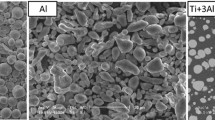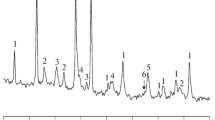Abstract
Combustion of exothermic mixtures belonging to the system Al-NaF-NaNO3 and Al-CaF2-NaNO3 was investigated by DTA and X-ray analysis. In order to determine the influence of the oxygen generated by dissociation of NaNO3, the mixtures containing NaNO2 or Na2O2 instead of NaNO3 were also examined.
Two exothermic reactions starting at 310° and 850° rsp. were found in the mixtures of the Al-NaF-NaNO3 type. The first is due to the dissociation of NaNO3 and the second proceeds independence of the availability of air.
Both exothermic reactions were shifted to higher temperatures in the system Al-CaF2-NaNO3. Investigation of the mixtures containing NaNO2 or Na2O2 instead of NaNO3 has proved that the dissociation of NaNO3 supplies the oxygen required for combustion which should otherwise proceed only in a limited extent.
Résumé
On a étudié, par ATD et par analyse aux rayons X, la combustion des mélanges exothermiques appartenant aux systèmes Al-NaF-NaNO3 et Al-CaF2-NaNO3. Afin de déterminer l'influence de l'oxygène engendré par la dissociation de NaNO3, on a étudié de même des mélanges contenant NaNO2 ou Na2O2 au lieu de NaNO3.
On a trouvé, dans les mélanges du type Al-NaF-NaNO3, des réactions exothermiques à partir des temperatures respectives de 310° et 850°. La première est due à la dissociation de NaNO3 et la seconde dépend de l'air disponible.
Dans le système Al-CaF2-NaNO3 les deux réactions sont déplacées vers les températures plus élevées. L'examen de mélanges contenant NaNO2 ou Na2O2 au lieu de NaNO3 à montré que c'est la dissociation de NaNO3 qui fournit l'oxygène nécessaire pour la combustion. Celleci n'aurait lieu, autrement, que d'une manière limitée.
Zusammenfassung
Das Verbrennen von Mischungen der exothermen Systeme Al-NaF-NaNO3 und Al-CaF2-NaNO3 wurde durch Röntgenanalyse ergänzte DTA untersucht. Um den Einfluß des durch Dissoziation von NaNO3 gebildeten Sauerstoffs zu bestimmen wurden auch Mischungen, welche anstatt NaNO3 NaNO2 oder Na2O2 enthielten, geprüft.
Zwei, bei 310° bzw. 850° einsetzende exotherme Reaktionen wurden in den Gemischen vom Typ Al-NaF-NaNO3 gefunden. Die erste ist der Dissoziation von NaNO3 zuzuschreiben, die zweite ist der Anwesenheit von Luft zuzuordnen.
Beide exothermen Reaktionen wurden im System Al-CaF2-NaNO3 in Richtung höherer Temperaturen verschoben. Die Untersuchung der NaNO2- oder Na2O2-haltigen Gemische anstatt NaNO3 zeigte, daß die Dissoziation von NaNO3 den zum Verbrennen benötigten Sauerstoff liefert, andererseits würde letztere Reaktion sonst nur in begrenztem Ausmaß stattfinden.
Резюме
С помощью ДТА и рентге новского анализа был о исследовано горение экзотермических смесей, относящихся к системе Аl-NaF-NaNO3 и Al-CaF2-NaNO3. Для того чтобы определить вли яние кислорода, получ аемого при диссоциации NaNO3, были ис следованы, вместо NaNO3, смеси, содерж ащие NaNO2 или Na2. Найдено, ч то в смесях Al-NaF-NaNO3 типа, две экзотерми ческие реакции начин аются при 310° и 850°. Первая реакция обусловлена диссоциацией нитрат а натрия, а вторая протекает в за висимости от наличия воздуха. Обе э кзотермические реак ции в системе Al-CaF2-NaNO3 смещены к более высоким темпер атурам. Исследование систем, содержащих NaNO2 или Na2O2, вм есто нитрата натрия, показ ало, что диссоциация н итрата натрия поставляет ки слород, требуемый для горения, которое п роисходит только в ог раниченной степени.
Similar content being viewed by others
Literature
C.Pelhan und B.Dobovišek, Schnelle Kontrolle von Gießereihilfsmitteln, Procédé du 34e Congrès international de Fonderie, Paris, 1967, Mem. No. 13, 1–13.
C. Pelhan undN. Majcen, Gießerei-Forschung (Düsseldorf), 23 (1971) 29.
C.Pelhan und A.Rosina, Gießerei-Praxis (Berlin), (1974) 117.
A.Rosina und C.Pelhan, Gießerei-Praxis (Berlin), (1974) 123.
A. Rosina undC. Pelhan, J. Thermal Anal., 11 (1977) 29.
Gmelins Handbuch der anorganischen Chemie, 8. Aufl., Verlag Chemie, Weinheim, 1966, Na Erg 973, S. 1007.
C. Duval, Inorganic Thermogravimetric Analysis, Sec. Edit., Elsevier, (Amsterdam, London, New York), 1963, S. 200.
A. A. Šidlovskij, Osnovi pirotehniki, Izd. tretie, Masinostroenije, Moskva, 1964, S. 24.
P. Pascal, Nouveau Traité de Chimie Minérale, Tom II, Masson et Cie, Paris, 1966, S. 616.
O.-A. Neumüller, Römpps Chemie Lexikon, 7. Aufl., Franckh'sche Verlagshandlung, Stuttgart, 1974, S. 2281.
Author information
Authors and Affiliations
Rights and permissions
About this article
Cite this article
Rosina, A., Pelhan, C. Verfolgung der Verbrennungsreaktionen Exothermer Massen auf Basis von Aluminium, Fluoriden und Natriumverbindungen mit Differenzialthermoanalyse. Journal of Thermal Analysis 17, 371–381 (1979). https://doi.org/10.1007/BF01914028
Received:
Published:
Issue Date:
DOI: https://doi.org/10.1007/BF01914028




